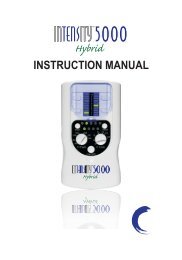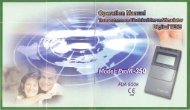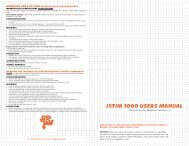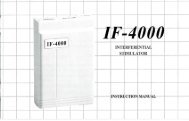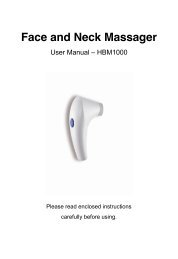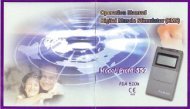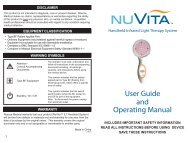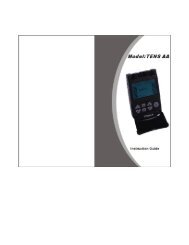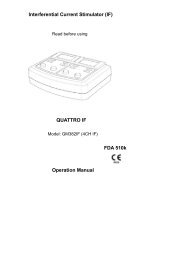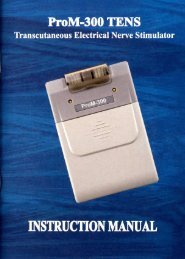TENS EV-803P Manual - Current Solutions LLC
TENS EV-803P Manual - Current Solutions LLC
TENS EV-803P Manual - Current Solutions LLC
Create successful ePaper yourself
Turn your PDF publications into a flip-book with our unique Google optimized e-Paper software.
Chapter 11 : ATTACHMENT OF ELECTRODE LEAD<br />
WIRES<br />
The wires provided with the system insert into the jack sockets<br />
located on top of the device. Holding the insulated portion of the<br />
connector, push the plug end of the wire into one of the jacks (see<br />
drawing); one or two sets of wires may be used.<br />
After connecting the wires to the stimulator, attach each wire to<br />
an electrode. Use care when you plug and unplug the wires.<br />
Jerking the wire instead of holding the insulated connector body<br />
may cause wire breakage.<br />
CAUTION<br />
Do not insert the plug of the patient lead wire into the AC power<br />
supply socket.<br />
Chapter 14 : ELECTRODE PLACEMENT<br />
The placement of electrodes can be one of the most important<br />
parameters in achieving success with <strong>TENS</strong> therapy. Of utmost<br />
importance is the willingness of the clinician to try the various styles<br />
of electrode placement to find which method best fits the needs of<br />
the individual patient.<br />
Every patient responds to electrical stimulation differently and their<br />
needs may vary from the conventional settings suggested here. If<br />
the initial results are not positive, feel free to experiment. Once an<br />
acceptable placement has been achieved, mark down the electrodes<br />
sites and the settings on the patient’s Reference sheet of this manual,<br />
so the patient can easily continue treatment at home.<br />
CONTIGUOUS PLACEMENT<br />
This is the most common placement technique. It involves placing the<br />
electrodes alongside the area of localized pain site, in such a way<br />
as to direct the flow of current through or around the area of pain.<br />
In a single channel application, this would involve placing each pad<br />
on either side of the pain site if the pain is localized on a limb and<br />
deep within the tissue. Pad placement on the posterior and anterior<br />
aspects of the affected limb will allow the current to flow completely<br />
through the limb and thus through the endogenous pain site.<br />
Chapter 12: LEAD WIRE MAINTENANCE<br />
Clean the wires by wiping with a damp cloth. Coating them lightly<br />
with talcum powder will reduce tangling and prolong life.<br />
Chapter 13 : ELECTRODE OPTIONS<br />
Your clinician will decide which type of electrode is best for your<br />
condition. Follow application procedures outlined in electrode packing,<br />
to maintain stimulation and prevent skin irritation. Use of legally<br />
marketed Electrodes is recommended.<br />
14<br />
With a two channels application, the clinician may either direct the<br />
current flow to cross through the pain site or, in what is called the<br />
“bracket” method allowing the current flow on either side of the<br />
painful area, generally through the nerve branches that feed into the<br />
pain site.<br />
DERMATOMES, MYOTOMES AND SCLEROTOMES<br />
These are the regions of the body enervated by one spinal nerve.<br />
Electrode placement involves both stimulating across the similarly<br />
enervated area and/or placing one electrode (or set of electrodes)<br />
at the pain site and another electrode (set) at the point where the<br />
nerve root joins the spinal cord.<br />
15<br />
PDF created with FinePrint pdfFactory trial version http://www.pdffactory.com



